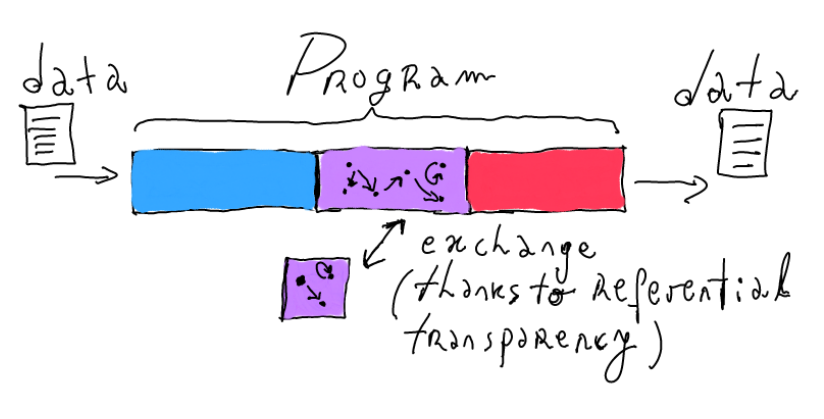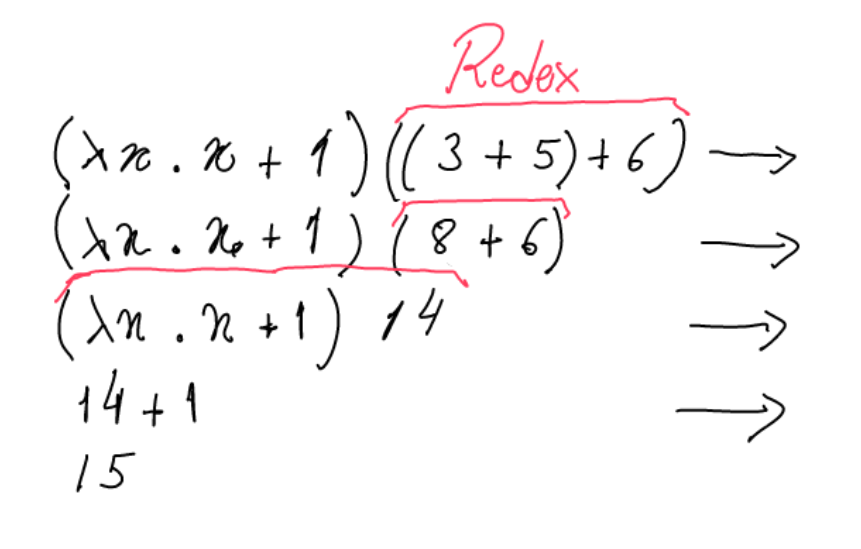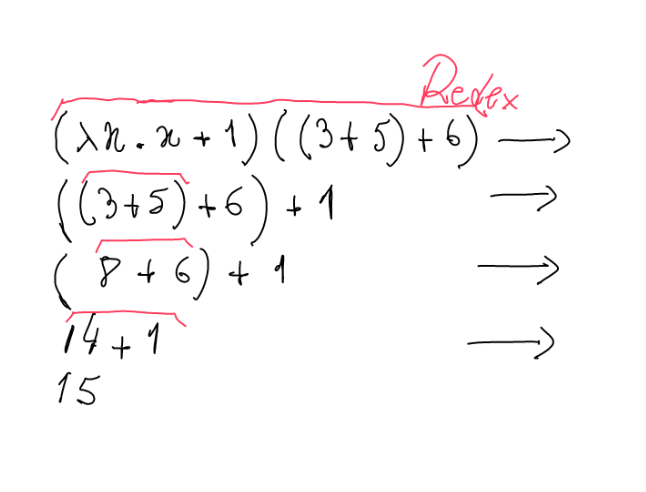Introduction to the course
This course
- Advanced Programming Language Features
- Type systems
- Programming techniques
- Program calculation and equational reasoning
- In the context of Functional Programming
- Haskell
- Agda
- Applications
- Signals processing, graphics, web programming, security
- Domain Specific Languages
Self study
- You need to read yourself
- Find out information yourself
- Solve problems yourself
- With (a lot of) help from us!
Getting help
- Course homepage
- It should be comprehensive -- complain if it is not!
- Discussion board
- Discuss general topics, find lab partner, etc.
- Don't post (partial or complete) lab solutions
- Office hours
- A few times a week. Check the hours here.
- Send e-mails to teachers (myself and the assistants)
- Organizational help, lectures, etc. (Lecturer)
- Specific help with programming labs (Assistants)
Organization
- 2 Lectures per week
- Including a few guest lectures
- Two exercise sessions (we solve, for example, previous exams)
- 3 Programming assignments (labs)
- Done in pairs (use the discussion groups to pair up)
- No scheduled lab supervision (use the office hours instead!)
- 1 Written exam**Final grade: 60% labs + 40% exam**
Recalling Haskell
- Purely functional language
- Functions vs. actions
- Referential transparency
- Lazy evaluation
- Things are evaluated when needed and at most once
- Advanced (always evolving) type system
- Polymorphism
- Type classes
- Type families
- etc.
- Quiz menti.com 8725 3240:
What is the result of ensurePrime 4?
error "not prime"4- non-termination
Functions vs. Actions
Consider
f :: String -> Int
Only the knowledge about the string is needed to produce the result. We say that
fis a pure function.What about external input and output?
Haskell has a distinctive feature with respect to other programming languages:
Pure code is separated from that which could affect the external world!How?
Types!Code which has side-effects in the real world has type
IO a(for somea).g :: String -> IO Int
As
f, this function produces an action which, when executed, produces an integer. However, it mightuse anything to produce it, e.g., data found in files, user input, randomness, and
modify anything, e.g., files, send packages over the network, etc.
Programming with IO
Interacting with the user:
hello :: IO () hello = do putStrLn "Hello! What is your name?" name <- getLine putStrLn $ "Hi, " ++ name ++ "!"
A program that enumerates and prints a list of strings:
> printTable ["1g saffran", "1kg (17dl) vetemjöl", "5dl mjölk", "250g mager kesella", "50g jäst", "1.5dl socker", "0.5tsk salt"] 1: 1g saffran 2: 1kg (17dl) vetemjöl 3: 5dl mjölk 4: 250g mager kesella 5: 50g jäst 6: 1.5dl socker 7: 0.5tsk salt >printTable :: [String] -> IO () printTable = prnt 1 -- Note the use of partial application where prnt :: Int -> [String] -> IO () prnt _i [] = return () prnt i (x : xs) = do putStrLn $ show i ++ ": " ++ x prnt (i + 1) xsIO actions are first class, i.e., you can pass them around and store them as any other value.
Can we write
printTabledifferently?Let us create a list of actions and then sequentially show them.
printTable2 :: [String] -> IO () printTable2 xs = sequence_ [ putStrLn $ show i ++ ":" ++ x | (x, i) <- xs `zip` [1 .. length xs] ] sequence_ :: [IO ()] -> IO () -- Prelude
Referential transparency
Quiz menti.com 8725 3240: In which languages (if any) does the distributive law
(x + y) * f() = x * f() + y * f()hold?- Haskell
- Java
- Python
What is it? "...An expression may contain certain 'names' which stand for unknown quantities, but it is normal in mathematical notation to presume that different occurrences of the same name refer to the same unknown quantity... "
"...the meaning of an expression is its value and there are no other effects, hidden or otherwise, in any procedure for actually obtaining it. Furthermore, the value of an expression depends only on the values of its constituent expressions (if any)..."
Source: R. Bird and P. Wadler, Introduction to Functional Programming, 1st edition, Section 1.2, page 4
What does it buy us?
Equational reasoning, i.e., expressions can be freely changed by others that denote the same value.

Example associativity of the append function:
(xs ++ ys) ++ zs = xs ++ (ys ++ zs)
What about programs with I/O?
In Haskell, expressions of type
IO a(for some typea) are pure expressions which denote (describe) I/O actions.In other words, an expression of type
IO ais not the computation itself but rather a pure description of it.This enable us to also do equational reasoning on IO actions.
Unfortunately, we do not always have the definition of the functions describing I/O effects (e.g.,
putStrLn,getLine, etc.). Nevertheless, we can still do some reasoning based on the underlying structure ofIO(monad). For instance, the codedo putStrLn "Hi!" name <- getLine return $ "hi! " ++ name
is equivalent to
do putStrLn "Hi!" name <- getLine return 42 return $ "hi! " ++ name
Referential transparency in practice
In practice, changing expressions by others denoting the same values might have consequences in:
- memory and energy consumption
- performance
Evaluation of expressions often trigger a lot of side-effects (memory allocation, garbage collector, etc.) even though they are pure.
That expressions denote the same value does not mean that they are equally convenient to use in practice!
Evaluation orders
Eager evaluation
Most programming language use this strategy: ML (OCaml), Java, Python...
Variables are bound to values, not expressions. So, function arguments are reduced to values before calling the function.

Eager evaluation Programmer dictates the execution order by the structure of their code. The runtime overhead is usually small. It promotes early error propagation. Evaluation of unnecessary expressions. Programmers need to organize the code for optimal execution based on the reduction order.
Lazy evaluation
Haskell is a lazy language.
Expressions are evaluated only when needed.
Expressions are evaluated at most once.
(We will explore more in detail what this means.)

Observing evaluations in Haskell
Use
error "message"orundefinedto see whether something gets evaluated.testLazy2 = head [3, undefined, 17] testLazy3 = head (3 : 4 : error "no tail") testLazy4 = head [error "no first elem", 17, 13] testLazy5 = head (error "no list at all")
Lazy evaluation: skipping unnecessary computations
Consider the following functions
-- | Fibonacci expn :: Integer -> Integer expn n | n <= 1 = 1 | otherwise = expn (n-1) + expn (n-2) choice :: Bool -> a -> a -> a choice False f _t = f choice True _f t = tFunction
expnis "expensive" to compute. Do you see why?What does happen when running...?
testChoice1 :: Integer testChoice1 = choice False 17 (expn 99) testChoice2 :: Integer testChoice2 = choice False 17 (error "Don't touch me!")
Lazy evaluation: programming style
Programs separate the
- construction
- and selection of data for a given purpose.
Modularity: "It makes it practical to modularise a program as a generator which constructs a large number of possible answers, and a selector which chooses the appropriate one."
Lazy evaluation: when is a value "needed"?
An argument is evaluated when a pattern match occurs
strange :: Bool -> Integer strange False = 17 strange True = 17 testStrange = strange undefined
Primitive functions also evaluate their arguments.
Lazy evaluation: at most once?
ff :: Integer -> Integer ff x = (x - 2) * 10 foo :: Integer -> Integer foo x = ff x + ff x bar :: Integer -> Integer -> Integer bar x y = ff 17 + x + y testBar = bar 1 2 + bar 3 4
ff xgets evaluated twice infoo x.ff 17is evaluated twice intestBar.Why is that?
In lazy evaluation, bindings are evaluated at most once!
We can adapt
fooabove to evaluateff xat most once by introducing a local binding:foo :: Integer -> Integer foo x = ffx + ffx where ffx = ff x
The evaluation happens at most once in the corresponding scope!
What about
f 17? How can we changebarto evaluate it at most once?bar :: Integer -> Integer -> Integer bar = \ x y -> ff17 + x + y where ff17 :: Integer ff17 = ff 17We introduce a binding
ff17that can be evaluated before the function arguments are passed.
Lazy evaluation: infinite lists
Because of laziness, Haskell is able to denote infinite structures.
They are not computed completely!
Instead, Haskell only computes the needed parts from them.
Infinite lists examples:
take n [3..] xs `zip` [1..]
We can write "generic code" which gets "instantiated" to the appropriate case.
printTable3 :: [String] -> IO () printTable3 xs = sequence_ [ putStrLn $ show i ++ ":" ++ x | (x, i) <- xs `zip` [1..] ] testTable3 = printTable3 lussekatterObserve that
ziptakes an infinite list[1..]but it will only uselength xsmany elements.Other examples
Raising functions to a positive power:
iterate :: (a -> a) -> a -> [a] iterate f x = x : iterate f (f x)
> iterate (2*) 1 [1,2,4,8,16,32,64,128,256,512,1024,...]
Repeating an element infinitely:
repeat :: a -> [a] repeat x = x : repeat x
Creating periodic lists:
cycle :: [a] -> [a] cycle xs = xs ++ cycle xs
Alternative, non-recursive definitions:
repeat :: a -> [a] repeat = iterate id cycle :: [a] -> [a] cycle xs = concat (repeat xs)
Lazy evaluation: infinite lists exercises
Problem: let us define the function
replicate :: Int -> a -> [a] replicate = ?
such that
> replicate 5 'a' "aaaaa"
replicate :: Int -> a -> [a] replicate n x = take n (repeat x)
Problem: grouping lists elements into lists of equal size.
chunksOf :: Int -> [a] -> [[a]] chunksOf = ?
> chunksOf 4 "thisthatok!" ["this", "that", "ok!"] > chunksOf 4 "thisthatok!!" ["this", "that", "ok!!"]
chunksOf n = takeWhile (not . null) . map (take n) . iterate (drop n)Function composition
(.)connects data processing "stages" -- like Unix pipes!Problem: prime numbers
primes :: [Integer] primes = ?
> take 4 primes [2,3,5,7]
primes :: [Integer] primes = sieve [2..] where sieve (p : xs) = p : sieve [ y | y <- xs, y `mod` p /= 0 ] sieve [] = error "sieve: empty list is impossible"This algorithm is commonly mistaken for Eratosthenes' sieve -- see that paper The Genuine Sieve of Eratosthenes for more details.
Lazy evaluation: infinite data structures
Consider the following data structure:
data Labyrinth = Crossroad { what :: String , left :: Labyrinth , right :: Labyrinth }Let us define a labyrinth.
labyrinth :: Labyrinth labyrinth = start where start = Crossroad "start" forest town town = Crossroad "town" start forest forest = Crossroad "forest" town exit exit = Crossroad "exit" exit exitWhat does it happen when we print out
labyrinth?
Lazy evaluation: conclusions
| Lazy evaluation |
|---|
| Avoids unnecessary computations (a different programming style). |
| Provides error recovery. |
| Allows to describe infinity data structures. |
| Can make programs more modular. |
| Makes complexity analysis hard. |
| Is not suitable for time-critical operations. |
Type classes
It is a distinctive feature in Haskell.
What does it provide?
- Systematic manner of achieving overloading.
- Enables some type-level programming.
Examples
class Eq a where -- simplified version (==) :: a -> a -> Bool class Eq a => Ord a where -- simplified version (<=) :: a -> a -> Bool (>=) :: a -> a -> Bool instance Eq Int where (==) = somePrimitiveEqualityTest somePrimitiveEqualityTest :: Int -> Int -> Bool somePrimitiveEqualityTest = ...
Let us consider the following type class.
class Finite a where domain :: [a]
What types could be an instance of this class? Can you make functions instances of
Eqnow?
Focus of this course
- Libraries ⇔ little languages
- Express and solve a problem
- In a problem domain
- Programming languages
- General purpose
- Domain-specific
- Description languages (e.g., JavaScript, HTML, Postscript)
- Embedded languages
- A little language implemented as a library
Typical embedded language
- Modeling the behavior of elements in a problem domain
- Functions for creating elements
- Constructor functions
- Functions for modifying or combining elements
- Combinators
- Functions for observing elements
- Run functions